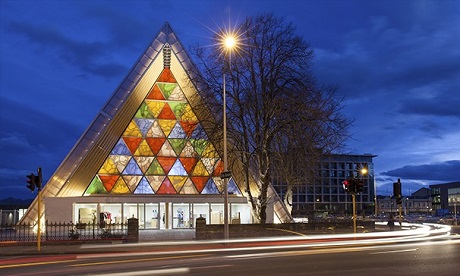The future of Christchurch’s Cardboard Cathedral is suddenly looking uncertain. Options could include sale or deconstruction, reports say.
Questions about the cathedral’s fate arose over the weekend when the parish it belongs to agreed to dissolve.
Christchurch’s Anglican Bishop Peter Carrell says this agreement enables options for the parish’s property to be considered. The property includes the Cardboard Cathedral and the land it stands on.
Whatever happens, the Anglican community will continue to use the Cardboard Cathedral (formally called the Transitional Cathedral} until 2027, the bishop says. That’s when the earthquake-damaged Christ Church Cathedral is set to reopen for worship.
He clarified that it won’t be possible for both cathedrals to function at the same time.
The Transitional Cathedral opened opposite Latimer Square in 2013 as a temporary place of worship. The unique, award-winning building soon became popular with locals and tourists alike.
Carrell said he understands many Cantabrians have become attached to the building. He knows they don’t want it sold or demolished. Their feelings would be factored into the final decision, he said.
Sadness and loss
Many Cantabrians are alarmed and concerned about the Cardboard Cathedral’s future.
They don’t want it sold or put to secular use – such as a pub.
But the structure is on prime piece of real estate which is “screaming out” for redevelopment, says Christchurch real estate agent Mark O’Loughlin. He knows the site well.
“That site there is 4,000 square metres of land … [it]… could sell for between $1500 to possibly $1800 a square metre,” he told 1News.
Such comments have seen those concerned for the cathedral’s future speak out.
The Reverend Craig Dixon is one who has made his views clear. He led the Cardboard Cathedral project after the 2011 earthquake.
“It seems to be a quick way to grab some cash to throw at the cathedral at the square,” he says.
“I think that’s an unfortunate response.
“It’s a publicly significant building for Christchurch and for New Zealand and was the first public building to be constructed post-earthquakes.
“There are people in Christchurch very attached to the transitional cathedral and some of them were present in our synod and spoke up in favour of it being retained as a building.
“It is an amazing building and so our consideration of future possible uses will look into how it might still remain as a building, it won’t be our cathedral.”
Options open
Carrell says the diocese is not committed to selling the Cardboard Cathedral site, but is exploring various options.
“The Synod was very clear that for some Cantabrians, there is a strong attachment … it is an award winning, iconic building…
“How the building might be retained and who might take responsibility for its future maintenance and insurance costs is something we will be looking into,” he says.
A working group will explore potential futures for the land and buildings on the corner of Madras and Hereford Streets, and report to the Anglican synod in 2024.
Source
